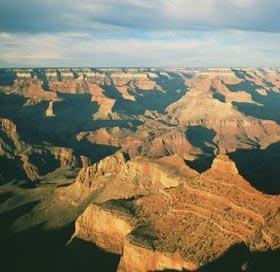 The Grand Canyon may owe its existence to a much older gorge.
The Grand Canyon may owe its existence to a much older gorge.Visitors are often told that the Grand Canyon formed 6 million years ago, when the Colorado River assumed its current course. But a new study indicates that a large chunk of the Grand Canyon may have taken its shape from a far more ancient gorge, carved out 55 million years ago by a river flowing in the opposite direction.
New dating of the canyon's Upper Granite Gorge suggests that this older, 1,000-metre-deep gorge may have been a rough template for the eastern third of the Grand Canyon. The Colorado River may have later used this same gorge to begin etching out the 450-kilometre-long Grand Canyon.
The results sketch out a dramatic history of the Colorado Plateau, which was pushed up by geological forces as long as 80 million years ago. An old river flowed across the plateau creating this 'proto-canyon', and then many different streams eroded away the top 2,000 metres of the entire plateau, bringing it to its present elevation.
"We're seeing a record of an ancestral Grand Canyon that was incised in rocks above the Grand Canyon and subsequently lowered to its present state," says Rebecca Flowers of the University of Colorado, Boulder. The results will be published in the May issue of Geological Society of America Bulletin 1.
Dating game
Flowers and her colleagues used a relatively new dating technique that examines levels of uranium and helium isotopes in rock samples containing the mineral apatite.
Because the test is sensitive to temperature, the team was able to estimate that rocks in the Upper Granite Gorge were exposed by erosion to cooler levels near Earth's surface roughly 55 million years ago.
What's more, the rim and the bottom of the canyon seemed to be roughly the same age. This suggested that a canyon-like feature must have existed long before the area was worn down by erosion and the present-day rocks were exposed.
"I was surprised. I didn’t believe the results at first," says co-author Brian Wernicke, a geologist at the California Institute of Technology in Pasadena. "That canyon has survived all that erosion up until the present day."
An old idea
Many have suspected that ancient rivers flowed across the Colorado Plateau long before the Grand Canyon formed. The area boasts a number of deep 'paleocanyons' that seem to have been carved by ancient waterways. Flowers' "study just confirms what we've been saying for the last 20 years", says Richard Young, a geologist at the State University of New York, Geneseo.
The Grand Canyon's history was revised when a study that dated cave deposits released last month in Science indicated that the Colorado River may have begun incising the mile-deep canyon 20 million years ago2.
This new study does not, however, change estimates of the Grand Canyon's age, which is tied to that of the Colorado River. Still some say the apatite results do not necessarily support the idea of an ancient Grand Canyon template.
The dating "is a very coarse tool for identifying the position of a canyon or the shape of it", says geologist Karl Karlstrom of the University of New Mexico in Albuquerque. "I don't think it's fair to call it a proto-Grand Canyon."
The 55 million year-old proto-canyon is likely to have looked very different from the present-day Grand Canyon. But, says Flowers, "the evidence suggests that a canyon of comparable dimension to what we have today must have existed at that time".



No comments:
Post a Comment